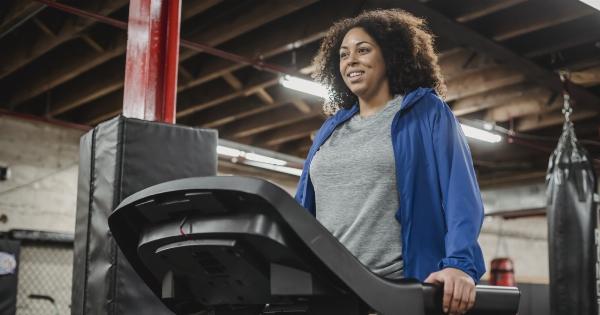As we age, our bodies go through a series of changes that can sometimes leave us feeling stuck or limited in certain aspects of our lives.
One common complaint among seniors is feeling stuck to their seats, whether it be due to physical discomfort, lack of mobility, or other health issues. In this article, we will explore the reasons behind this feeling and offer some solutions to help you regain your freedom and live a more active lifestyle.
Understanding the Issue
Feeling stuck to your seat can have various underlying causes. Let’s take a look at some of the possible reasons:.
1. Musculoskeletal Issues
As we age, our muscles and joints may become weaker or develop conditions such as arthritis, making it more difficult to move around freely.
The discomfort or pain associated with these conditions can make it challenging to get up from a seated position or stay on your feet for extended periods of time.
2. Decline in Bone Density
Osteoporosis, a condition characterized by low bone density, is common among older adults, particularly postmenopausal women.
This condition can increase the risk of fractures and make movements that require putting weight on the legs, such as standing up, more difficult and uncomfortable.
3. Lack of Exercise
Sedentary lifestyles can contribute to muscle weakness and reduced flexibility, which can make getting up from a seated position more challenging. Lack of regular physical activity can also lead to weight gain, further exacerbating the issue.
4. Chronic Health Conditions
Health conditions such as obesity, diabetes, and cardiovascular diseases can affect mobility and make it harder to get up from a sitting position.
These conditions often require medication that can cause dizziness or affect muscle coordination, adding to the feeling of being stuck to your seat.
5. Fear of Falling
Many seniors develop a fear of falling, which can significantly impact their mobility.
The fear of injuring oneself can lead to hesitancy in getting up from a seated position or avoiding certain movements altogether, ultimately reinforcing the feeling of being stuck.
Solutions for Regaining Mobility
Fortunately, there are several strategies and lifestyle changes that can help alleviate the feeling of being stuck to your seat and enhance your mobility:.
1. Stay Active
Regular exercise is crucial for maintaining muscle strength and flexibility. Engage in activities that are appropriate for your fitness level, such as walking, swimming, or gentle yoga.
Consult with a healthcare professional or a certified trainer to design an exercise regimen that suits your needs and conditions.
2. Incorporate Strength Training
Strength training exercises can help improve muscle tone and bone density. Consider using resistance bands or lightweights to perform exercises that target major muscle groups.
Again, it’s important to seek guidance from a professional to ensure safety and effectiveness.
3. Practice Balance Exercises
Balance exercises are essential for preventing falls and enhancing stability. Simple exercises such as standing on one leg or practicing yoga poses that improve balance can go a long way in reducing the fear of falling and increasing overall mobility.
4. Make Adjustments to Your Sitting Area
If your chair or sofa is too low or too soft, it can be challenging to get up from a seated position. Consider using chairs with armrests or cushions that provide better support.
Adjusting the height of your seat or using a raised cushion can also make it easier to stand up more comfortably.
5. Environmental Adaptations
Make your living space more accessible and senior-friendly. Install grab bars in bathrooms, remove obstacles or area rugs that can cause tripping accidents, and ensure that pathways are well-lit.
These adaptations can help you feel more confident and secure while moving around your home.
6. Seek Professional Help
If you’re struggling with mobility issues, don’t hesitate to seek help from healthcare professionals.
Physical therapists, occupational therapists, or geriatric specialists can provide personalized guidance and exercises tailored to your specific needs.
7. Modify Your Routine
Look for opportunities to incorporate movement in your daily routine. Stretch during television commercials, take short walks around your house every hour, or engage in hobbies that require physical activity.
Small changes can have a significant impact on your overall mobility.
8. Address Underlying Health Conditions
If chronic health conditions are contributing to your feeling of being stuck, it’s important to work closely with your healthcare provider to manage these conditions effectively.
Proper management may involve medication adjustments, physical therapy, or additional interventions to improve mobility.
9. Stay Positive and Motivated
Having a positive mindset and staying motivated can greatly influence your ability to overcome mobility challenges.
Surround yourself with supportive individuals and consider joining social groups or senior centers that offer activities tailored to seniors’ needs.
10. Embrace Assistive Devices
Assistive devices such as canes, walkers, or mobility scooters can provide additional support and help you maintain an active lifestyle. Consult with a healthcare professional to determine which device is best suited for your specific needs.
Conclusion
Feeling stuck to your seat at 65 doesn’t have to be a permanent situation. By understanding the potential causes of this feeling and implementing some lifestyle modifications, you can regain your freedom and live a more active and fulfilling life.
Remember, it’s never too late to make positive changes that can significantly improve your mobility and overall well-being.































